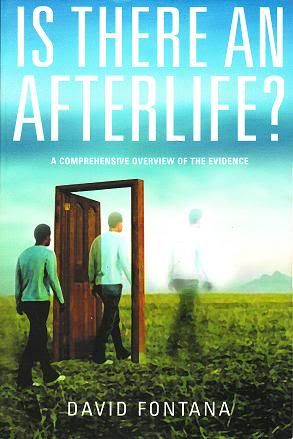
The founders of the Society for Psychical Research in 1882 hoped that it would transform the question of survival of death. What had formerly been the province of religion and philosophy was to yield its secrets to science.
If they were to look back today at the 128 years since then, they might be disappointed. There has been a good deal of research, some of it of very high quality, but it remains on the fringe of conventional science. Most scientists -- most people, actually, in the Western world -- are indifferent or skeptical.
With a handful of exceptions, psychical research (or "parapsychology," as its academic practitioners prefer to call it because it sounds more respectable) is conspicuously invisible in universities and other institutions. Even many parapsychologists shy away from survival research as a poor career choice. Teaching jobs and grants are thin on the ground. Such is the fruit of the prevailing materialist world view.
Nevertheless, while they occupy an orbit distant from Groupthink Central, some determined scientists as well as individuals who understand experimental protocols continue to try to accumulate and understand evidence for personal survival of death. Among them is psychologist David Fontana, author of Is There an Afterlife?
A little background: Fontana is a past president of the Society for Psychical Research and has been active in the organization for decades. He teaches at Cardiff University in Wales and Liverpool John Moores University and was one of the three investigators of the remarkable Scole sessions. (I was introduced to him at an SPR conference, but unfortunately there was no occasion to converse, and we only exchanged pleasantries.)
His book is the single best overview of survival research, and phenomena purporting to indicate survival, that I've read. It calmly surveys a great body of evidence, and analyzes it in what seems to me an eminently fair way. He recognizes that there is good evidence and dodgy evidence, and a great deal whose validity can't be determined. He considers the criticisms of the research and the quality of the reporting, and often regrets that -- especially in older cases -- more care was not taken to confirm the stories of witnesses, or that present-day recording technology was unavailable. (Nevertheless, if you nurse an idea that early psychical researchers were gullible, this book will convince you otherwise; Fontana goes to great lengths to describe the strict precautions many took against possible cheating.)
The book touches on almost every type of paranormal phenomena: telepathy, clairvoyance, poltergeists, apparitions, near-death experiences, out-of-the-body experiences, instrumental transcommunication (electronic voice phenomena and the like) and, not least, the most controversial: mediumship. Not all of these can be claimed as evidence of life after death, but he discusses them because they are often suggested as alternative explanations for what seems to be communication from discarnate spirits.
For instance, if a medium supplies information that only you and a deceased relative or friend knows about, does that prove the medium is forwarding a message from the beyond? Maybe not. The alternative explanation is that telepathy or clairvoyance, for which there is overwhelming laboratory evidence, is responsible. The medium could be picking it up from your mind or from physical clues lying around, such as the deceased's diary.
Fontana carefully weighs the so-called "super ESP theory," which posits that all supposed post-mortem communication, as well as apparitions of the dead and numerous other paranormal experiences, are caused by living minds. One problem with the super-ESP theory is that it is, at least theoretically, unfalsifiable. If you assume living minds can do anything, then even the most astonishing spirit manifestations can be explained that way. Another problem with it is that there is no evidence that the living can produce many extraordinary phenomena that have been reported countless times by highly reputable witnesses. (Fontana gives some eyewitness testimony of his own, particularly about his experience of a poltergeist and of the Scole experiment, but in a matter-of-fact style, just more data points.)
The evidence he assembles and discusses is intended to provide ample material for the reader's own judgment. Despite the length of the book (close to 500 pages), I sense at times that he is frustrated at not being able to go into even more detail or offer yet more examples because of space limitations. There is a good reference list, although it has one problem I'll get to presently.
Is There an Afterlife? has a wrap-up chapter on a particularly interesting subject: according to the evidence from alleged spirit communicators, NDEs, and other sources, what is the afterlife like? Some of its commonly reported characteristics, which would seem far-fetched if placed at the book's front end, are likely to be more credible after Fontana's exploration of more than a century's psychical research.
Is there proof that we continue in a spirit dimension (or dimensions) after we die? No — but ask yourself what would constitute objective proof. It is hard to imagine what that might be … although many who have had NDEs consider it a fact of personal experience. For the rest of us, answers must derive from a consideration of the entire body of evidence as a whole, not individual bits. Fontana's achievement is that he offers both the raw material and his own non-dogmatic assessments to help you reach a reasonable tentative conclusion.
Unfortunately, his manuscript's afterlife has been rubbished by the publisher, from its cheesy cover illustration to the editing, if you can call it that. O-books Publishing is based in the U.K., but they had someone (mostly) change British spelling variants into American ones. Sometimes the text uses American style double quotation marks, sometimes British 'inverted commas.'
I don't think I have ever encountered a book from a supposedly reputable trade publisher with so many misspellings, typos, and syntactical errors. Possibly Fontana was responsible for some of them, but I doubt very much he would spell the name of Alan Gauld, his colleague for decades (and himself the author of another good survival study) as "Alan Gould." Many condensed in-text references, for example "Groff 1975" -- that should probably be "Grof" for Stanislav Grof -- are not matched by corresponding full entries in the reference section.
The back cover, which Fontana certainly didn't write, has a blurb from "Professor William Braud, Institute of Transpersonal Psychology, Paol Altum, California." That's Palo Alto to you, mates, although you spelled California right, perhaps by accident. It is regrettable that such an able and thorough analysis of the evidence for and against survival has been cheapened by a publisher -- printer would be a more apt term -- that apparently doesn't care about production quality.
But I belong to the writer-editor tribe, so maybe others won't be so fussed about such things. In any case, I recommend Is There an Afterlife? to anyone who has pondered the question posed by the title.
If they were to look back today at the 128 years since then, they might be disappointed. There has been a good deal of research, some of it of very high quality, but it remains on the fringe of conventional science. Most scientists -- most people, actually, in the Western world -- are indifferent or skeptical.
With a handful of exceptions, psychical research (or "parapsychology," as its academic practitioners prefer to call it because it sounds more respectable) is conspicuously invisible in universities and other institutions. Even many parapsychologists shy away from survival research as a poor career choice. Teaching jobs and grants are thin on the ground. Such is the fruit of the prevailing materialist world view.
Nevertheless, while they occupy an orbit distant from Groupthink Central, some determined scientists as well as individuals who understand experimental protocols continue to try to accumulate and understand evidence for personal survival of death. Among them is psychologist David Fontana, author of Is There an Afterlife?
A little background: Fontana is a past president of the Society for Psychical Research and has been active in the organization for decades. He teaches at Cardiff University in Wales and Liverpool John Moores University and was one of the three investigators of the remarkable Scole sessions. (I was introduced to him at an SPR conference, but unfortunately there was no occasion to converse, and we only exchanged pleasantries.)
His book is the single best overview of survival research, and phenomena purporting to indicate survival, that I've read. It calmly surveys a great body of evidence, and analyzes it in what seems to me an eminently fair way. He recognizes that there is good evidence and dodgy evidence, and a great deal whose validity can't be determined. He considers the criticisms of the research and the quality of the reporting, and often regrets that -- especially in older cases -- more care was not taken to confirm the stories of witnesses, or that present-day recording technology was unavailable. (Nevertheless, if you nurse an idea that early psychical researchers were gullible, this book will convince you otherwise; Fontana goes to great lengths to describe the strict precautions many took against possible cheating.)
The book touches on almost every type of paranormal phenomena: telepathy, clairvoyance, poltergeists, apparitions, near-death experiences, out-of-the-body experiences, instrumental transcommunication (electronic voice phenomena and the like) and, not least, the most controversial: mediumship. Not all of these can be claimed as evidence of life after death, but he discusses them because they are often suggested as alternative explanations for what seems to be communication from discarnate spirits.
For instance, if a medium supplies information that only you and a deceased relative or friend knows about, does that prove the medium is forwarding a message from the beyond? Maybe not. The alternative explanation is that telepathy or clairvoyance, for which there is overwhelming laboratory evidence, is responsible. The medium could be picking it up from your mind or from physical clues lying around, such as the deceased's diary.
Fontana carefully weighs the so-called "super ESP theory," which posits that all supposed post-mortem communication, as well as apparitions of the dead and numerous other paranormal experiences, are caused by living minds. One problem with the super-ESP theory is that it is, at least theoretically, unfalsifiable. If you assume living minds can do anything, then even the most astonishing spirit manifestations can be explained that way. Another problem with it is that there is no evidence that the living can produce many extraordinary phenomena that have been reported countless times by highly reputable witnesses. (Fontana gives some eyewitness testimony of his own, particularly about his experience of a poltergeist and of the Scole experiment, but in a matter-of-fact style, just more data points.)
The evidence he assembles and discusses is intended to provide ample material for the reader's own judgment. Despite the length of the book (close to 500 pages), I sense at times that he is frustrated at not being able to go into even more detail or offer yet more examples because of space limitations. There is a good reference list, although it has one problem I'll get to presently.
Is There an Afterlife? has a wrap-up chapter on a particularly interesting subject: according to the evidence from alleged spirit communicators, NDEs, and other sources, what is the afterlife like? Some of its commonly reported characteristics, which would seem far-fetched if placed at the book's front end, are likely to be more credible after Fontana's exploration of more than a century's psychical research.
Is there proof that we continue in a spirit dimension (or dimensions) after we die? No — but ask yourself what would constitute objective proof. It is hard to imagine what that might be … although many who have had NDEs consider it a fact of personal experience. For the rest of us, answers must derive from a consideration of the entire body of evidence as a whole, not individual bits. Fontana's achievement is that he offers both the raw material and his own non-dogmatic assessments to help you reach a reasonable tentative conclusion.
Unfortunately, his manuscript's afterlife has been rubbished by the publisher, from its cheesy cover illustration to the editing, if you can call it that. O-books Publishing is based in the U.K., but they had someone (mostly) change British spelling variants into American ones. Sometimes the text uses American style double quotation marks, sometimes British 'inverted commas.'
I don't think I have ever encountered a book from a supposedly reputable trade publisher with so many misspellings, typos, and syntactical errors. Possibly Fontana was responsible for some of them, but I doubt very much he would spell the name of Alan Gauld, his colleague for decades (and himself the author of another good survival study) as "Alan Gould." Many condensed in-text references, for example "Groff 1975" -- that should probably be "Grof" for Stanislav Grof -- are not matched by corresponding full entries in the reference section.
The back cover, which Fontana certainly didn't write, has a blurb from "Professor William Braud, Institute of Transpersonal Psychology, Paol Altum, California." That's Palo Alto to you, mates, although you spelled California right, perhaps by accident. It is regrettable that such an able and thorough analysis of the evidence for and against survival has been cheapened by a publisher -- printer would be a more apt term -- that apparently doesn't care about production quality.
But I belong to the writer-editor tribe, so maybe others won't be so fussed about such things. In any case, I recommend Is There an Afterlife? to anyone who has pondered the question posed by the title.




No comments:
Post a Comment